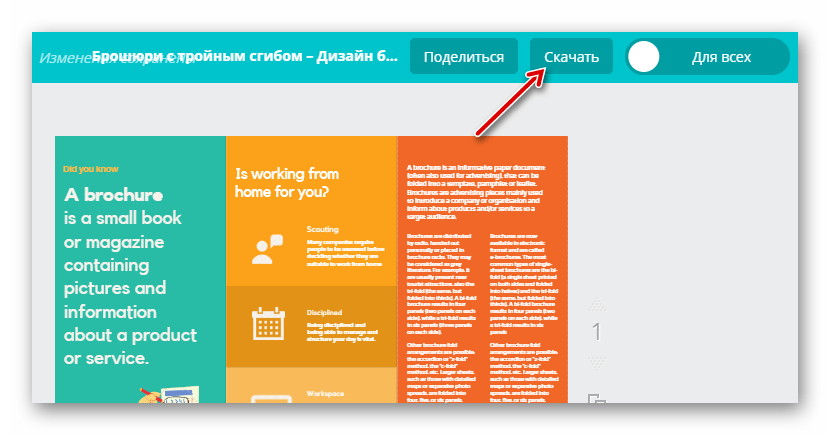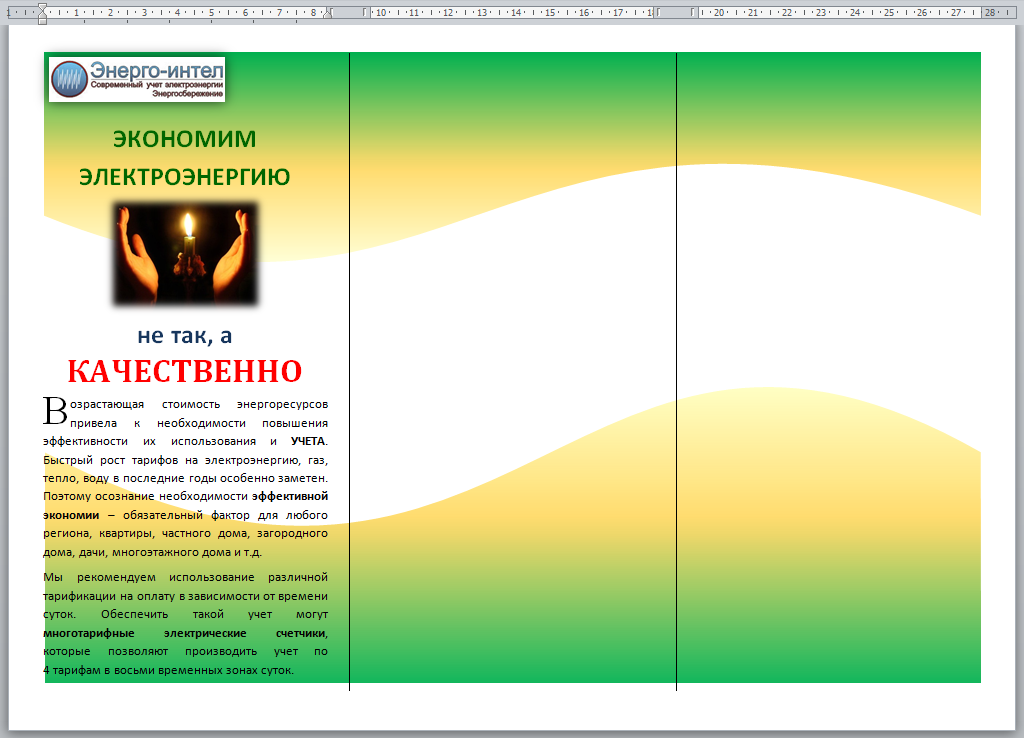Shablon Bukleta V Word

A brochure is an informative paper document (often also used for advertising) that can be folded into a template,. A brochure can also be a set of related unfolded papers put into a pocket folder or packet. Brochures are promotional documents, primarily used to introduce a,, or and inform prospective customers or members of the public of the benefits. Brochures are distributed in many different ways: as newspaper inserts, handed out personally, by mail or placed in brochure racks in high traffic locations especially in tourist precincts.
Similarly, the Legislature was aware that in Saunderlin v. DuPont Co., 102 N.J. 402, 508 A.2d 1095 (1986), we interpreted the provision of the Workers' Compensation Act, N.J.S.A. 34:15-36, permitting coverage for a “ ‘[d]isability permanent in quality and partial in character ․ which restricts the function of the body or of its.
They may be considered as. 1: letter/C tri-fold, 2: gate tri-fold, 3: roll/double gate fold, 4: accordion z-fold, 5: double (parallel) fold, 6: double right-angle / French fold Brochures available in electronic format are called e-brochures. This format has the added benefit of unlimited distribution and cost savings when compared to traditional paper brochures. Anestesiologia de morgan pdf gratis espaol. The most common types of single-sheet brochures are the bi-fold (a single sheet printed on both sides and folded into halves) and the tri-fold (the same, but folded into thirds). A bi-fold brochure results in four panels (two panels on each side), while a tri-fold results in six panels (three panels on each side). Other are possible: the accordion or 'z-fold' method, the 'c-fold' method, etc. Larger sheets, such as those with detailed maps or expansive photo spreads, are folded into four, five, or six panels.
When two card fascia are affixed to the outer panels of the z-folded brochure. Booklet brochures are made of multiple sheets most often, stapled on the creased edge, or like a, and result in eight or more panels. Editing and design [ ] Brochures and leaflets are carefully edited to promote an organization or business, to sell a service or product, raise awareness or to champion a cause.
Editors will be clear who they are trying to reach and define their target audience. They will also be conscious of skillful layout and design aimed at attracting the attention of their readers. Printing [ ] Brochures are often printed using on thick, glossy paper to give an impression of quality. Businesses may print small quantities of brochures on a or on a, but turns out higher quantities at a lower cost per unit. Compared with a flyer, a brochure usually uses, more color, and is folded. See also [ ].

• • • Ecchi ( エッチ, etchi, pronounced ) is an often used term in the Japanese language for playfully sexual actions. As an, it is used with the meaning of 'sexy', 'dirty' or 'naughty'; as a, ecchi wo suru ( エッチをする), with the meaning to have sex; or as a, to describe someone of. It is perhaps softer than the Japanese word ero (エロ from ), and does not imply perversion in the way does. The word ecchi has been adopted by fans of Japanese media to describe works with sexual overtones. In Japanese, the word ecchi is often used to describe a person's conduct, but in fandom, it has come to be used to refer to or playful sexuality, as distinct from the word hentai, which connotes perversion or fetishism.
Works described as ecchi do not show or genitalia, but sexual themes are referenced. Ecchi themes are a type of, and can be found in most comedy. Contents • • • • • • • Etymology and use in Japan [ ] The correct transcription of the word エッチ in notation is 'etchi'. However, it is typically written as 'ecchi'. [ ] In the word hentai,(変態) the first kanji 'hen' refers to strangeness, and the second kanji 'tai' refers to a condition or state. Hentai was introduced in the as a term for change of form or transformation in. In this context, it was used to refer to disorders such as or to describe like.
Slowly, the meaning expanded until it had the meaning of non-standard. In the 1910s, it was used in in the compound expression 'hentai seiyoku' ( 変態性欲, abnormal sexual desire) and became popular within the theory of sexual deviance ( Hentai seiyoku ron), published by Eiji Habuto and Jun'ichirō Sawada in 1915.
In the 1920s, many publications dealt with deviant sexual desires and the movement. Matsuzawa calls it a period characterized by a ' hentai boom'. In the 1930s, censorship became more common leading to fewer books being published on this theme. After the Second World War, in the 1950s, interest in hentai was renewed, and people would sometimes refer to it just by the first English letter, H (pronounced as エッチ, ). In 1952, the magazine Shukan Asahi reported that a woman who was groped by a stranger in a movie theater reacted with 'ara etchi yo' ( 'hey, that's perverse'). In this context, etchi should be understood as sexually forward and is synonymous to iyarashii ( 嫌らしい, dirty or disgusting) or sukebe ( すけべ, a person with sex on the brain). From this, the word etchi started to branch off, and assume new connotations.